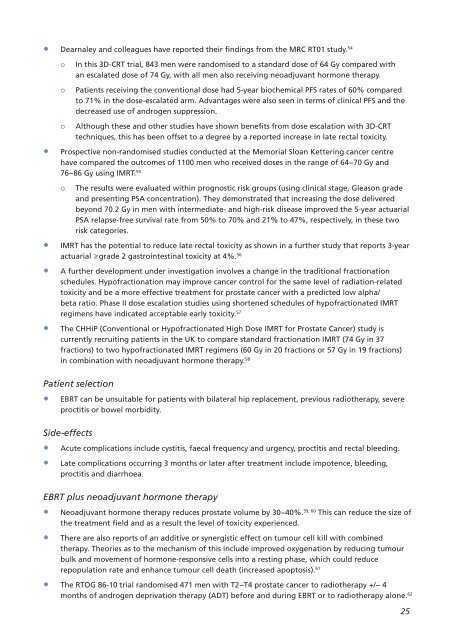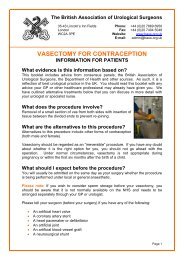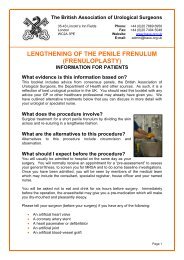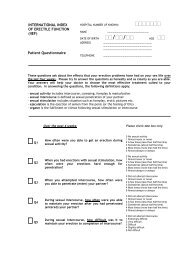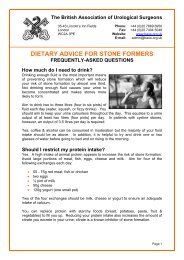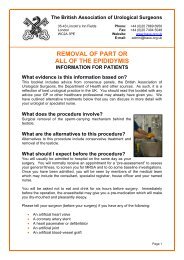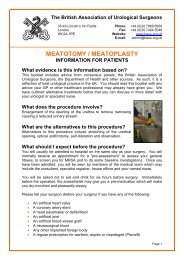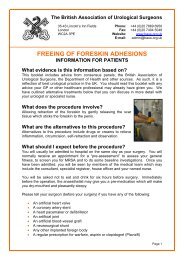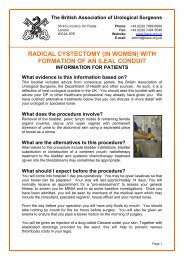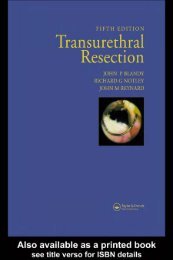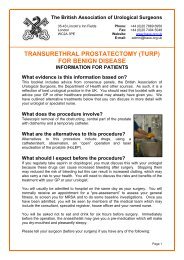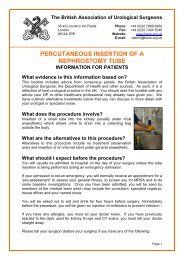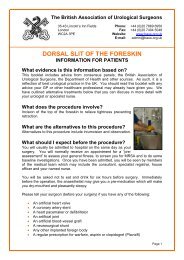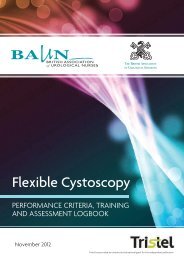MDT (multi-disciplinary team) guidance for managing prostate cancer
MDT (multi-disciplinary team) guidance for managing prostate cancer
MDT (multi-disciplinary team) guidance for managing prostate cancer
Create successful ePaper yourself
Turn your PDF publications into a flip-book with our unique Google optimized e-Paper software.
• Dearnaley and colleagues have reported their findings from the MRC RT01 study. 54<br />
o In this 3D-CRT trial, 843 men were randomised to a standard dose of 64 Gy compared with<br />
an escalated dose of 74 Gy, with all men also receiving neoadjuvant hormone therapy.<br />
o Patients receiving the conventional dose had 5-year biochemical PFS rates of 60% compared<br />
to 71% in the dose-escalated arm. Advantages were also seen in terms of clinical PFS and the<br />
decreased use of androgen suppression.<br />
o Although these and other studies have shown benefits from dose escalation with 3D-CRT<br />
techniques, this has been offset to a degree by a reported increase in late rectal toxicity.<br />
• Prospective non-randomised studies conducted at the Memorial Sloan Kettering <strong>cancer</strong> centre<br />
have compared the outcomes of 1100 men who received doses in the range of 64−70 Gy and<br />
76−86 Gy using IMRT. 55<br />
o The results were evaluated within prognostic risk groups (using clinical stage, Gleason grade<br />
and presenting PSA concentration). They demonstrated that increasing the dose delivered<br />
beyond 70.2 Gy in men with intermediate- and high-risk disease improved the 5-year actuarial<br />
PSA relapse-free survival rate from 50% to 70% and 21% to 47%, respectively, in these two<br />
risk categories.<br />
• IMRT has the potential to reduce late rectal toxicity as shown in a further study that reports 3-year<br />
actuarial ≥grade 2 gastrointestinal toxicity at 4%. 56<br />
• A further development under investigation involves a change in the traditional fractionation<br />
schedules. Hypofractionation may improve <strong>cancer</strong> control <strong>for</strong> the same level of radiation-related<br />
toxicity and be a more effective treatment <strong>for</strong> <strong>prostate</strong> <strong>cancer</strong> with a predicted low alpha/<br />
beta ratio. Phase II dose escalation studies using shortened schedules of hypofractionated IMRT<br />
regimens have indicated acceptable early toxicity. 57<br />
• The CHHiP (Conventional or Hypofractionated High Dose IMRT <strong>for</strong> Prostate Cancer) study is<br />
currently recruiting patients in the UK to compare standard fractionation IMRT (74 Gy in 37<br />
fractions) to two hypofractionated IMRT regimens (60 Gy in 20 fractions or 57 Gy in 19 fractions)<br />
in combination with neoadjuvant hormone therapy. 58<br />
Patient selection<br />
• EBRT can be unsuitable <strong>for</strong> patients with bilateral hip replacement, previous radiotherapy, severe<br />
proctitis or bowel morbidity.<br />
Side-effects<br />
• Acute complications include cystitis, faecal frequency and urgency, proctitis and rectal bleeding.<br />
• Late complications occurring 3 months or later after treatment include impotence, bleeding,<br />
proctitis and diarrhoea.<br />
EBRT plus neoadjuvant hormone therapy<br />
• Neoadjuvant hormone therapy reduces <strong>prostate</strong> volume by 30−40%. 59, 60 This can reduce the size of<br />
the treatment field and as a result the level of toxicity experienced.<br />
• There are also reports of an additive or synergistic effect on tumour cell kill with combined<br />
therapy. Theories as to the mechanism of this include improved oxygenation by reducing tumour<br />
bulk and movement of hormone-responsive cells into a resting phase, which could reduce<br />
repopulation rate and enhance tumour cell death (increased apoptosis). 61<br />
• The RTOG 86-10 trial randomised 471 men with T2−T4 <strong>prostate</strong> <strong>cancer</strong> to radiotherapy +/− 4<br />
months of androgen deprivation therapy (ADT) be<strong>for</strong>e and during EBRT or to radiotherapy alone. 62<br />
25


